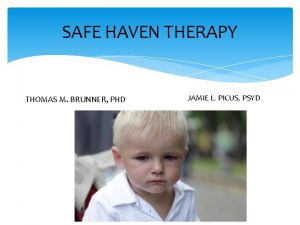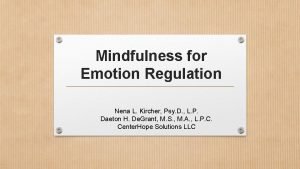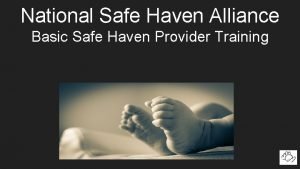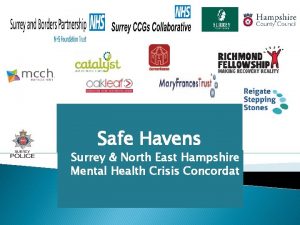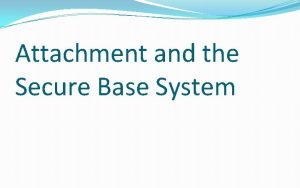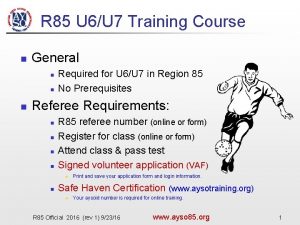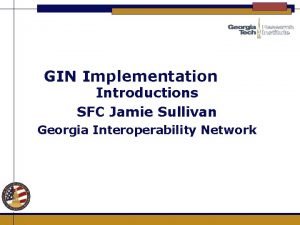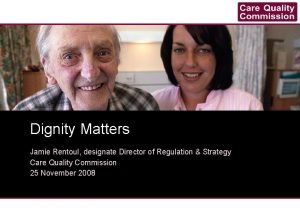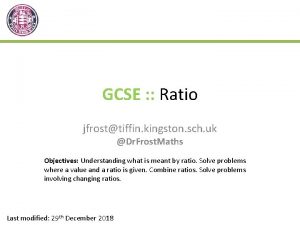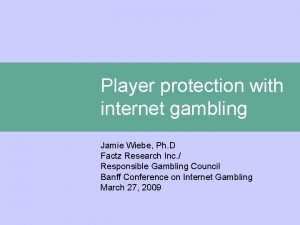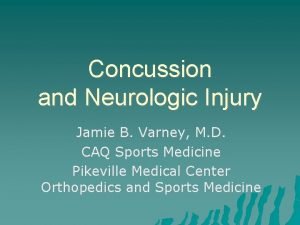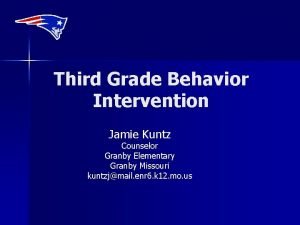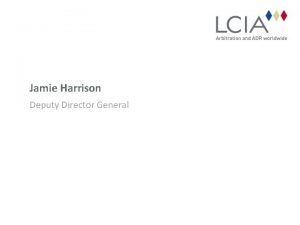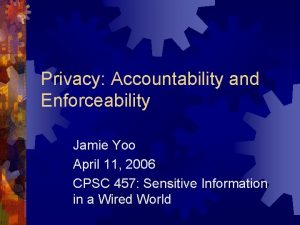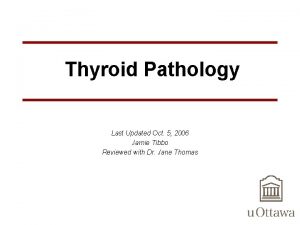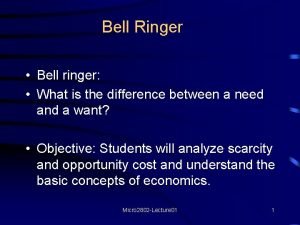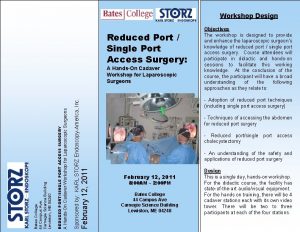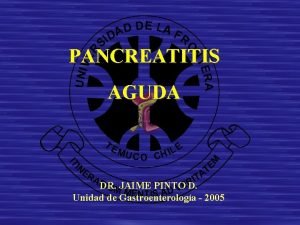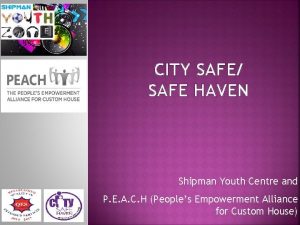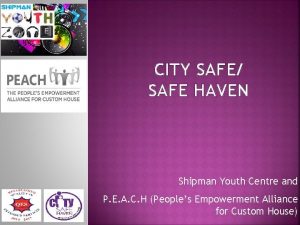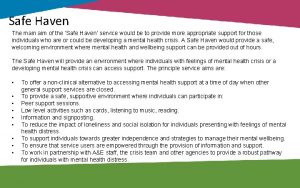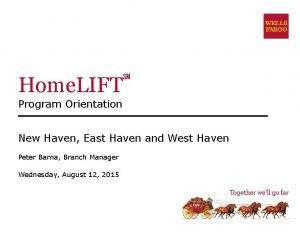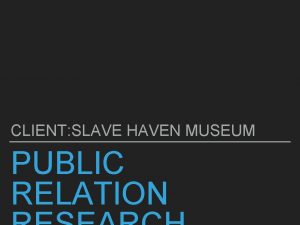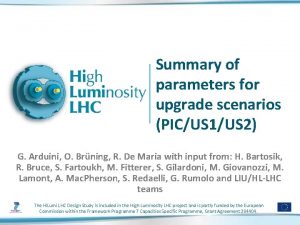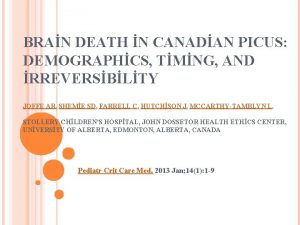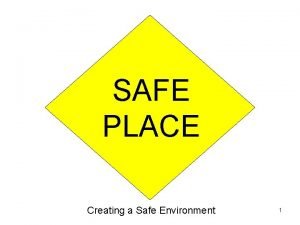SAFE HAVEN THERAPY JAMIE L PICUS PSYD THOMAS




















































- Slides: 52

SAFE HAVEN THERAPY JAMIE L. PICUS, PSYD THOMAS M. BRUNNER, PHD 1

Table of Contents Rationale & Context Core idea & Child “Therapeutic Due Process” Relevant Legal & Statutory references Conceptual status: Debate & Divisiveness Key psychological elements of Court Orders Future Considerations 2

Rationale & Context

Linguistic History of concept Often used with… Finite weather phenomenon Beer labels and Retirement plans 4

But the “weather” we are protecting the child from most often is not a temporary storm 5

Best image? Need consistently THICK walls of containment 6

UNHEALTHY, HARMFUL PARENTING Undermining therapeutic recommendations Refusal to follow recommendations Not letting child speak for self or dictate how the child uses therapy Play on child’s feelings, guilt Ridicule or shame child for meeting his/her needs Threaten child with loss of love (can be in passive-aggressive forms) Create conflict with child after talking in therapy and then lay blame on child, other parent or clinician for affecting the child’s emotional state Openly violate court orders Make false accusations of physical, sexual or emotional abuse toward other parent Not letting child speak in therapy Verbal, emotional or physical abuse against the other parent or clinician in front of the child in therapy setting Reject the other parent or clinician in front of the child in therapy setting Encourage child to reject or disrespect other parent or clinician Refuse or lack follow through in therapy or with supports when deemed necessary Encourage child to feign or threaten physical or emotional illness (e. g. , threaten suicide) 7

WHY SAFE HAVEN THERAPY? HEALING HOSTILITY, REVENGE & DESTRUCTIVE PARENTING “HOSTILE AGGRESSIVE PARENTING” and a CHILD’S THERAPY Pattern of a parent’s behaviors, actions and decision making that directly or indirectly: Creates difficulties between a child and his/her ability to utilize therapy Functions with the goal of damaging a child’s relationship with a therapist, which ultimately hinders the ability to utilize therapy. THIS IS A SERIOUS FORM OF DAMAGE, MALTREATMENT AND ABUSE TO CHILDREN 8

Healing Hostility, Revenge & Aggressive Parenting IMPORTANT FACTS 1) When parents allow their own unresolved grief and parent conflict to become or remain excessive, then the harmful and destructive impact on the children will grow in correspondence. 2) The inability for a parent to contain or manage his/her grief is a serious sign of psychological immaturity, an inability to regulate emotions, and/or a severe inability to empathize with his/her child —ultimately meeting parent (unhealthy needs) at the child’s expense. 3) Parent empathy is critical for healthy child development. True empathy is free of a parent’s projected issues.

How each Parent Views Therapist Degree of rapport widely varies Rarely do both parents fully support throughout See them as a “rival” or “threat” Constant scrutinizing Major differences b/t forensic therapy and traditional therapy (See handout) 10

Core Idea & Child “Therapeutic Due Process” 11

No matter who is doing it…. Psychologist, social worker, counselor, etc. Safe Haven/Safe Harbor counselor Court Interventionist Court Appointed therapist 12

What is child therapeutic Due Process? Will not exploit vulnerability Will not violate trust Will not break promise of confidentiality Be loyal Leads to disclosing trauma, secrets, Facilitates corrective cognitive/emotional experiences 13

Therapeutic due Process = Protection of the Therapeutic Alliance Relationship b/t patient and therapist Level of trust How feel about therapist There must be skillful development of: true understanding genuine interest common goals provides comfort & keep secrets Bottom Line to Irvin Yalom: Relationship of trust 14

15

Why is a Safe Haven SO important? Single greatest resilient indicator of which children will be in face of challenging situations: Presence of a Mentor 16

Purposes of a safe haven Improve mental health of child Rehabilitate family relationships Provide psychoeducation (PTSD) Facilitate better exchange dynamics Reporting maltreatment Facilitate conflict resolution 17

What kind of access will lead to a “leaky” therapy alliance? 18

Debate & Divisiveness 19

Core (i. e. , widely accepted) idea Have a MH professional who cannot be compelled to testify at court about what the child has said in the counseling sessions, and records of sessions cannot be subpoenaed by parents. Reasoning: Child should have a safe place to talk about his or her concerns and problems without worrying that everything he/she says will end up in court. It preserves doctor-patient privilege for the child. 20

Differing interpretations of Safe Haven… In terms of what we are protecting…. . Content Records Therapy session conversations with child Conversations with parents Therapist from having to testify/deposition 21

Ultimate Goal: Prevent Child from joining the epidemic population of psychologically impaired divorce survivors 22

Relevant Legal & Statutory References 23

US Supreme Court United States Supreme Court Cases Jaffee v. Redmond is a landmark case holding that “a privilege protecting confidential communications between a psychotherapist and her patient promotes sufficiently important interests to outweigh the need for probative evidence, ” and thereby recognizing the psychotherapist-patient privilege under Rule 501, Federal Rules of Evidence. 518 U. S. 1, 9 -10 (1996). The Supreme Court reasoned that “[e]ffective psychotherapy . . . depends upon an atmosphere of confidence and trust in which the patient is willing to make a frank and complete disclosure of facts, emotions, memories, and fears. ” Id. at 10. 24

Around the U. S. At least 8 states have specific statutes regarding permissibility of non-disclosure of a child’s mental health records to a parent if non-disclosure is found to be in the child’s best interests: Arizona, California, Illinois, Minnesota, North Dakota, Texas, Virginia, and Washington. At least 10 other states allow non-disclosure of a child’s mental health records based on applicable privilege statutes 25

AZ ARS 12 -2293: Stipulations for Nonrelease of medical records by a health care provider Core of Statutory Basis So…. a therapist may decide the patient (the child) could be harmed by revealing what the child has told therapist. Specifically, if therapist states that revealing information to the “patient’s health care decision maker” (i. e. , the parent) is “reasonably likely to cause substantial harm to the patient (or another person)”, Could also apply to processes like testimony or Subpoenas. 26

Unpublished AZ decision on Safe Haven issue Harepoo v. Dahnad, Division 1 of the AZ Court of Appeals Agreed w/ trial court that children’s therapy records would not be released to Father, based on therapist’s opinion that release of the records would not be in the children’s best interests. Memorandum decision references ARS 25 -408 K (the presumption of a parent’s entitlement to the child’s records) and its exception if such disclosure would “endanger seriously the child’s or a parent’s physical, mental, moral or emotional health. ” Trial court’s finding that the records would not be released was upheld. This decision does not mention ARS 12 -2293 B. Harepoo case cannot be cited as precedent in Arizona, unless it qualifies under Supreme Court Rule 111(c), as it is not a published opinion. 27

What if abuse/neglect involving child is alleged? ARS 13 -3620 is Arizona’s duty to report statute Subsection G provides that release of a child’s records does not violate privilege in the case of investigation of child abuse or neglect proceedings. So even if abuse or neglect is alleged and is the subject of police or agency investigations, no one can assert privilege to prevent the production of therapy records. 28

Conceptual status: Debate & Divisiveness 29

Differentiable Goals creating tension 30

Problem 1: “I’m out!!!” What do clinician’s do when pulled into court or have to testify? Answer: Termination b/c promise of confidentiality is gone 31

Problem 2: Frontloaded Safe Haven agreements Technically, a therapist must state that access is reasonably likely to cause harm, it stands to reason that therapy must have already started. Therapist not in position to state that records will cause harm if the records don’t exist yet. Safe haven agreements that are signed by the parents before the child’s therapy starts, are unreliable and arguably don’t meet the statutory standard. Recognize therapist needs to make a finding, after therapy has started, as to whether or not access to records are likely to cause harm. 32

Problem 3: Meaningfulness of evidentiary distinction to child Attorneys: safe haven should NOT protect communications b/t therapist and parent. Retort: Stmt’s to parents often deeply intertwined with what child has said to them > pulled into citing child’s comments to defend rationale. Then who looks like they are hiding something? Therapist! 33

34

What is the EVIDENCE that making therapist testify about communication with parents is any less NEGATIVELY impactful to therapy due process than if therapist made to testify about what child said?

AZ 12 -2293 – References a record, not what is being discussed or who are the discussants 12 -2293. Release of medical records and payment records to patients and health care decision makers; definition A. Except as provided in subsections B and C of this section, on the written request of a patient or the patient's health care decision maker for access to or copies of the patient's medical records and payment records, the health care provider in possession of the record shall provide access to or copies of the records to the patient or the patient's health care decision maker. B. A health care provider may deny a request for access to or copies of medical records or payment records if a health professional determines that either……. 36

AZ 12 -2293 (cont’d) 1. Access by the patient is reasonably likely to endanger the life or physical safety of the patient or another person. 2. The records make reference to a person other than a health professional and access by the patient or the patient's health care decision maker is reasonably likely to cause substantial harm to that other person. 3. Access by the patient's health care decision maker is reasonably likely to cause substantial harm to the patient or another person. 4. Access by the patient or the patient's health care decision maker would reveal information obtained under a promise of confidentiality with someone other than a health professional and access would be reasonably likely to reveal the source of the information. 37

Key Psychological elements of Court Orders 38

Handout: Mental health professional based perspective on what safe haven aspects are important, and which have psycholegal implications Blended in with a more generic form from other legal sources related to the matter Could sounds legalistic, but focused therapeutic value of this document If there is legal language, we wove psychological ideas into legal language Some references were from real world sources From various sources attorney and psychological sources 39

(6) Equalization of participation. Use a standard pre-meeting form Allows commensurate input Minimizes surprise complaints Weakens the non-participatory hijacker 40

(12) Informal complaints or concerns about counselor Before elevating to formal complaint, the parent must show a persistent track record of seeking to resolve their concern through a collaborative, ongoing, professional communication and problem solving process with therapist. 41

Criteria for SH success Strong, front loading court order (See Handout) Goes beyond generic recommendations Language to contain specific toxic parent behaviors Minimize parent claiming marginalization (See Handout) MOST IMPORTANT: Retain a bird’s eye view of probative claims 42

Future Considerations 43

IS IT WORTH IT? Sharing a child’s information can: Damage current trust in therapist Minimize or prevent ability to trust anotherapist Undermine years of therapeutic gain Result in LOSS of the ONE neutral support that supports the child’s needs ASIDE FROM from the adult issues 44

Goes beyond generic recommendations Cannot just say court ordered therapy Remember image of nuclear reactor Thick walls where necessary Prep - disastrous meltdowns Contain toxicity 45

TRUE GOAL -Since very fragile… …not merely stabilize but bring some healing and increase resilience 46

Reasons safe haven fails include…. Much less defined Most vulnerable May be artificially time-limited Therapist coerced/manipulated/complaints Psycholegal focus = hollow improvements 47

Bird’s eye view of Probative claims As a Wise person once said: Keep things in proportion 48

Key questions to ask if requesting therapist involvement… How much will the evidence seeking matter in 5 years? Is this evidence present elsewhere? Is this evidence likely to manifest elsewhere? Is a Summary of Treatment letter acceptable? Is there another way to get this information? 49

Serious potential problems with requesting various kinds of information 50

Growth on the surface, in times of storminess, requires deep rooted trust in a Mentor 51

Current tensions create diversity of choices case by case 52
 Jamie picus
Jamie picus Abnormal psychology ucf
Abnormal psychology ucf Nena kircher psyd
Nena kircher psyd National safe haven alliance
National safe haven alliance Ucl slms
Ucl slms Safe haven guildford
Safe haven guildford Safe haven vs secure base
Safe haven vs secure base Hartford safe haven program
Hartford safe haven program Ayso safe haven training definition
Ayso safe haven training definition Safe people safe places
Safe people safe places Safe feed safe food
Safe feed safe food Psychoanalytic therapy is to as humanistic therapy is to
Psychoanalytic therapy is to as humanistic therapy is to Psychodynamic and humanistic therapies have in common
Psychodynamic and humanistic therapies have in common Bioness bits cost
Bioness bits cost Pathologist and anthropologist
Pathologist and anthropologist Jamie sullivan traffic
Jamie sullivan traffic Jamie rentoul
Jamie rentoul Jamie buchenauer
Jamie buchenauer Jamie rosin
Jamie rosin Genetic hitchhiking
Genetic hitchhiking Jamie wallace bp
Jamie wallace bp Jamie markham
Jamie markham Dr frost ratio
Dr frost ratio Jamie montague
Jamie montague Jamie wiebe
Jamie wiebe Martin biewenga
Martin biewenga Radiohead just lyrics
Radiohead just lyrics La catrina episodio 2
La catrina episodio 2 Who is the pharmacist in romeo and juliet
Who is the pharmacist in romeo and juliet Jamie warren buffalo public schools
Jamie warren buffalo public schools Jamie varney
Jamie varney The jamie drake equation chapter 1
The jamie drake equation chapter 1 Jamie asaka
Jamie asaka Dr jamie castillo
Dr jamie castillo Many mumbling mice
Many mumbling mice Jamie payton movie horses
Jamie payton movie horses Jamie kuntz
Jamie kuntz Jamie knopf
Jamie knopf Jamie harrison lcia
Jamie harrison lcia Neha surapaneni
Neha surapaneni Jamie yoo
Jamie yoo Papillary thyroid carcinoma gross
Papillary thyroid carcinoma gross La catrina episode 1
La catrina episode 1 Jamie has a job paying 25 000
Jamie has a job paying 25 000 Jamie has enough money to buy either a mountain dew
Jamie has enough money to buy either a mountain dew What is inductive and deductive method
What is inductive and deductive method Jamie loggins md
Jamie loggins md Linea alba w jamie ustnej
Linea alba w jamie ustnej Jamie tried to solve an equation step by step.
Jamie tried to solve an equation step by step. Jamie stolk
Jamie stolk Dr jamie pinto
Dr jamie pinto Jamie markham unc
Jamie markham unc Jamie morgenstern
Jamie morgenstern
